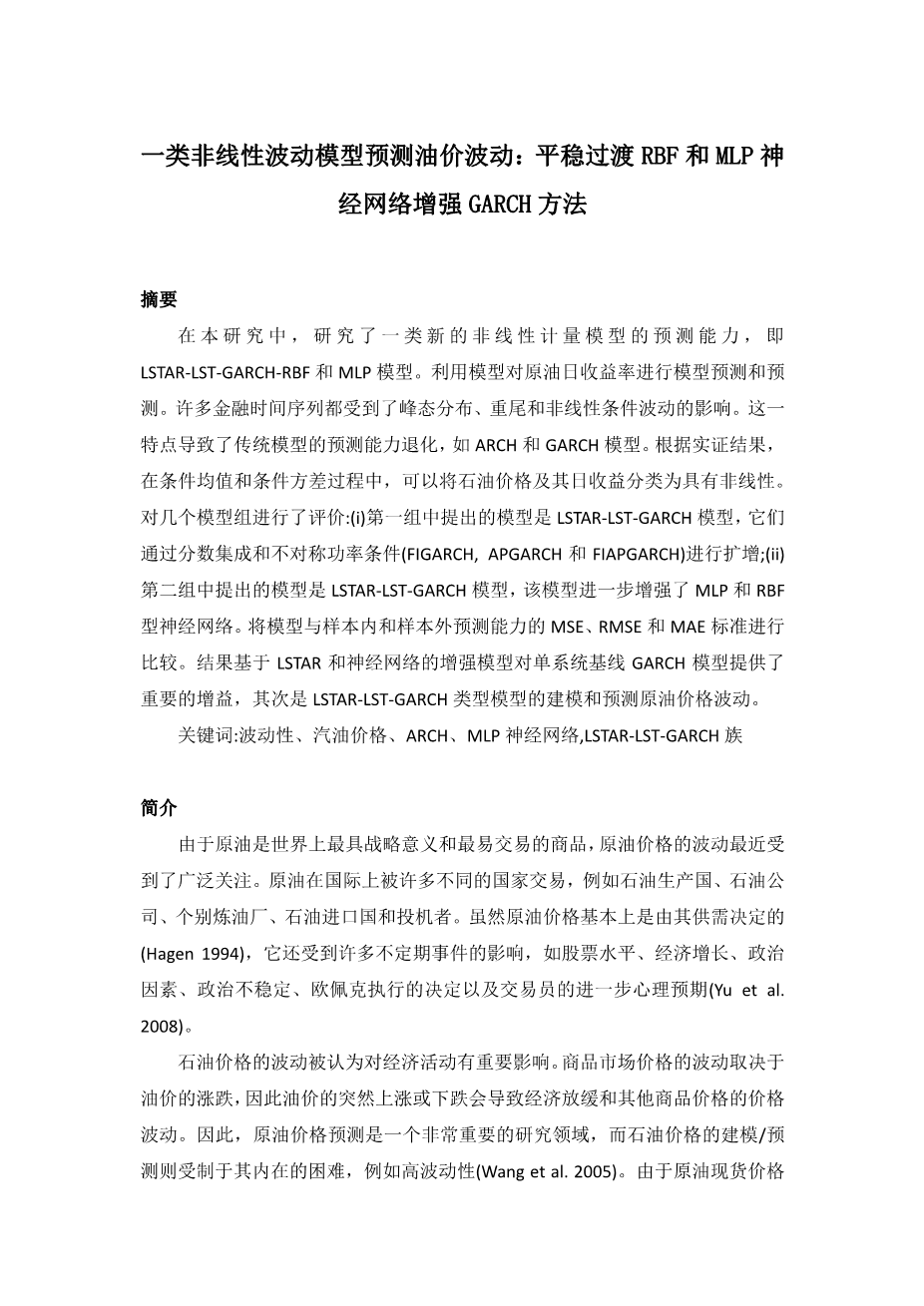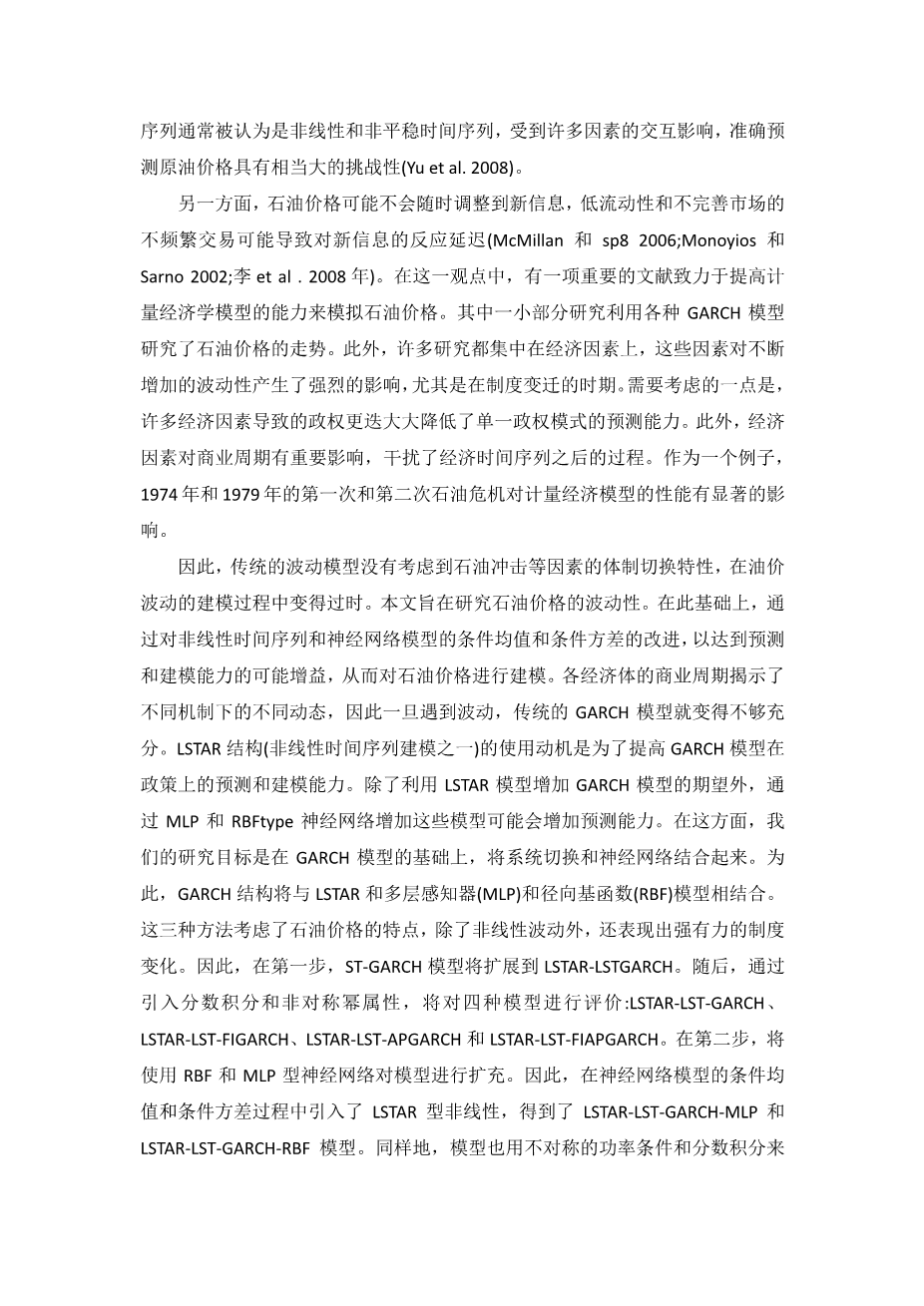Forecasting volatility in oil prices with a class of nonlinear volatility models: smooth transition RBF and MLP neural networks augmented GARCH approach
Abstract
In this study, the forecasting capabilities of a new class of nonlinear econometric models, namely, the LSTAR-LST-GARCH-RBF and MLP models are evaluated.The models are utilized to model and to forecast the daily returns of crude oil prices. Many financial time series are subjected to leptokurtic distribution, heavy tails, and nonlinear conditional volatility. This characteristic feature leads to deterioration in the forecast capabilities of traditional models such as the ARCH and GARCH models.According to the empirical findings, the oil prices and their daily returns could be classified as possessing nonlinearity in the conditional mean and conditional variance processes.Several model groups are evaluated: (i) the models proposed in the first group are the LSTAR-LST-GARCH models that are augmented with fractional integration and asymmetric power terms (FIGARCH, APGARCH, and FIAPGARCH); (ii) the models proposed in the second group are the LSTAR-LST-GARCH models further augmented with MLP and RBF type neural networks. The models are compared in terms of MSE, RMSE, and MAE criteria for in-sample and out-of-sample forecast capabilities.The results show that the LSTAR based and neural network augmented models provide important gains over the single-regime baseline GARCH models, followed by the LSTAR-LST-GARCH type models in terms of modeling and forecasting volatility in crude oil prices.
Keywords :Volatility ,Petrol prices ,ARCH ,STAR ,Neural networks, LSTAR-LST-GARCH family
Introduction
The volatility of crude oil prices has received much attention recently because the crude oil is the most strategic and the most traded commodity in the world. Crude oil is traded internationally by many different players such as the oil producing nations, oil companies, individual refineries, oil importing nations, and speculators. Although crude oil price is basically determined by its supply and demand (Hagen 1994; Stevens 1995), it is also under the influence of many irregular events like stock levels, economic growth, political aspects, political instability, the decisions implemented by OPEC, and further psychological expectations of traders (Yu et al. 2008).
The volatility of oil prices is accepted to have important effects on economic activity. The fluctuations of the commodity market prices depend on the rise-and-fall of the oil price so that any sudden increase or decrease in oil prices cause economic slowdown and price fluctuations in other commodity prices. As a result, crude oil price forecasting is a very important field of research, and modeling/forecasting oil prices is hindered by its intrinsic difficulties such as the high volatility (Wang et al. 2005).As the crude oil spot price series are usually considered as a nonlinear and nonstationary time series, which is interactively affected by many factors, predicting crude oil price accurately is rather challenging (Yu et al. 2008).
Oil prices may not always adjust instantaneously to new information, on the other hand, low liquidity and infrequent trading in imperfect markets could lead to a delay in response to new information (McMillan and Speight 2006;Monoyios and Sarno 2002; Lee et al. 2008). In this perspective,there is a significant literature focusing on improving the capabilities of econometric models to model oil prices. A fraction of the studies investigate the path followed by the oil prices by utilizing various GARCH models. In addition, many studies focus on the economic factors that have had strong impacts on the increasing volatility especially for the periods with regime changes.One point to be taken into consideration is the fact that regime changes caused by many economic factors decrease the forecast capabilities of the single-regime models drastically.Furthermore, economic factors have important effects on the business cycles by disturbing the processes followed by economic time series. As an example, the 1st and 2nd oil shocks in 1974 and 1979 had significantimpacts on the performances of the econometric models.
Consequently the traditional volatility models which do not take into consideration the regime switching characteristics of the factors such as oil shocks became obsolete in modeling volatility in petrol prices.In this paper, the volatility in oil prices is aimed to be investigated. In accordancewith this purpose, the oil prices will be modeled by improving both the conditional mean and the conditional variance with nonlinear time series and neural network models to achieve possible gains in forecasting and modeling capabilities. The business cycles in the economies reveal different dynamics under different regimes so that a traditional GARCH model becomes insufficient once volatility is encountered. The motive behind the usage of LSTAR structure (one of the nonlinear time series modeling) is to improving forecasting and modeling power of the GARCH models for policy purposes. In addition to the expectation of augmenting the GARCH models with LSTAR models, augmenting these models with MLP and RBFtype neural networks would likely to bring increase in the forecasting capabilities.With this respect, our study aims to incorporate regime switching and neural networks with GARCH models.With this purpose, GARCH structure will be incorporated with LSTAR and multi-layer perceptron (MLP) and radial basis function (RBF) models. These three approaches consider the characteristics of oil prices which exhibit strong regime changes in addition to nonlinear volatility. Accordingly, at the first step,ST-GARCH models will be extended to LSTAR-LSTGARCH.Afterwards, Hence, the LSTAR type, nonlinearity is introduced in the conditional mean and conditional variance processes of n
剩余内容已隐藏,支付完成后下载完整资料


英语译文共 4 页,剩余内容已隐藏,支付完成后下载完整资料
资料编号:[467475],资料为PDF文档或Word文档,PDF文档可免费转换为Word
以上是毕业论文外文翻译,课题毕业论文、任务书、文献综述、开题报告、程序设计、图纸设计等资料可联系客服协助查找。


